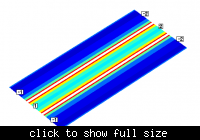ste2006
Advanced Member level 4
Transmission Line Design Advice for GSM Module???
First of all i know High Frequency PCB Design is a specialist area so please stay with me on this, I am an embedded engineer but need to lay out a PCB for a Telit GL865 GSM Module,
I have gone through the Hardware manual and think it best to stick to what they recommend as works and lay out a Grounded Coplanar Waveguide line on the top layer of my PCB. I am hoping to just use a double sided PCB and use a ground plane on the underside of the board beneath the transmission line on top. (If anyone has any better ideas please tell also)
My question is as follows:
If i use a short a line as possible to the female SMA connector does the actual length of the trace make a difference. I know the width of the trace, height of it, substrate, distance either side etc all are important but on any of the calculators i have used or materials i have read nothing seems to make refernce to the length of trace.
Is this important and if so how does it factor in to the calcualtions??
Secondly i am hoping to avoid using multilayer boards mainly due to cost but if i am using RF like this do i need a complete side of the board as a ground plane or can i get away with just under the module and transmission lines for a ground plane,
I will have to at some stage make sure it complies with EMC Regulations so please keep this in mind also,
Thanks in advance,
Thanks,
First of all i know High Frequency PCB Design is a specialist area so please stay with me on this, I am an embedded engineer but need to lay out a PCB for a Telit GL865 GSM Module,
I have gone through the Hardware manual and think it best to stick to what they recommend as works and lay out a Grounded Coplanar Waveguide line on the top layer of my PCB. I am hoping to just use a double sided PCB and use a ground plane on the underside of the board beneath the transmission line on top. (If anyone has any better ideas please tell also)
My question is as follows:
If i use a short a line as possible to the female SMA connector does the actual length of the trace make a difference. I know the width of the trace, height of it, substrate, distance either side etc all are important but on any of the calculators i have used or materials i have read nothing seems to make refernce to the length of trace.
Is this important and if so how does it factor in to the calcualtions??
Secondly i am hoping to avoid using multilayer boards mainly due to cost but if i am using RF like this do i need a complete side of the board as a ground plane or can i get away with just under the module and transmission lines for a ground plane,
I will have to at some stage make sure it complies with EMC Regulations so please keep this in mind also,
Thanks in advance,
Thanks,
Last edited:
